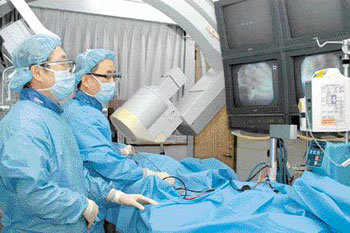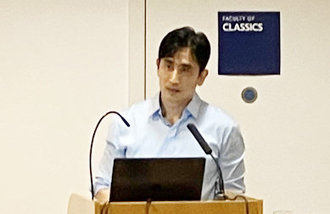Arrhythmia

Recently, on a visit to her sons house, Jeon Byeong-bun (65), who was very healthy, suddenly fainted. Her son, Hong Seong-bok, who was scared to death looking at his mother gasping for air and twitching her whole body with blank eyes, immediately called 911 while massaging her legs and arms. Luckily, Jeon regained her consciousness five minutes later, but she remained absentminded for another 30 minutes.
I got all kinds of brain-related check-ups at a nearby hospital. Computed tomography (CT), magnetic resonance imaging (MRI), and all other examinations that I had could not identify any abnormalities in my body. My lung was totally fine, too, she said.
Jeon visited Dr. Kim Jun-su at Samsung Medical Center cardiology department. After listening to Jeon, Dr. Kim immediately suspected arrhythmia.
Arrhythmia refers to a state of abnormal pulse of the heart; the heart either beats faster or slower than normal (60 to 100 pulsation per minute), or irregularly. Since the function of the heart does not work properly, the blood pressure can drop, which can lead to a swoon.
Most people think of a violently throbbing heart as a condition of arrhythmia, but a swoon is also a critical symptom of the disease. Since fainting by arrhythmia can lead to sudden death, it is essential to find out the cause of fainting, Dr. Kim warned.
He also said, Usually people swoon when they are standing for a long time without moving, when they feel extreme fear, or when they suddenly stand up after a meal. In such cases, people feel weak, dizzy, sick, and difficult to breathe, and yawn for several times. If such signs show, people can prevent fainting by immediately lying down.
However, in the case of Jeon, Dr. Kim suspected arrhythmia as the cause of the swoon, because: 1) no particular outside shock was given; 2) she did not feel sick and; 3) her consciousness was not very clear even after waking up.
He said, A faint due to arrhythmia is quite sudden, which is why it is like a hidden time bomb. First and foremost, for an exact diagnosis, one has to go through treadmill exercise test, which is an electrocardiogram test while running on a treadmill at hospital, 24-hour holter monitor, which tracks electrocardiogram changes during a normal 24-hour day, and finally clinical electrophysiological test, which induce arrhythmia by giving electric stimulus to the heart.
Is there any way to simply find out arrhythmia?-
The easiest way to do so is to check the pulse by lightly pressing the finger upon the wrist near the thumb area with the palm up. If the pulse is irregular (premature beat), beats faster than 100 pulsations/min without particular physical exercise (tachycardia), or slower than 60 pulsations/min (bradyrhythmia), it probably is arrhythmia. This kind of examination is quite inaccurate, however, since arrhythmia usually does not show in everyday life.
Jeon was hospitalized the very next day.
She showed no abnormalities from two electrocardiogram examinations, but arrhythmia was found in the treadmill exercise test. Jeon was suffering from tachycardia in the cardiac ventricle, which poses the highest risk of a sudden death. A ventricle is a critical part of the heart that pumps blood to the arteries. If a tachycardia in the cardiac ventricle occurs, the only effective treatment is electrotherapy, because the function of the heart is likely to stop.
Jeon decided to undergo an operation that finds out arrhythmia on its own and turns the heartbeat to normal by automatically giving electric shocks to it.
likeday@donga.com







